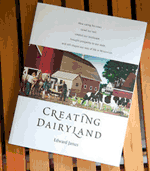 With his unique background and story-telling ability, author Ed Janus does an exceptional job capturing Wisconsin's rise to a major dairy state. "How caring for cows saved our soil, created our landscape, brought prosperity to our state, and still shapes our way of life in Wisconsin," is a fitting subtitle for Janus' colorful book.
With his unique background and story-telling ability, author Ed Janus does an exceptional job capturing Wisconsin's rise to a major dairy state. "How caring for cows saved our soil, created our landscape, brought prosperity to our state, and still shapes our way of life in Wisconsin," is a fitting subtitle for Janus' colorful book. A Washington, D.C., native who now calls Wisconsin home, Janus has a unique background. It includes being a partner on a dairy farm near Soldiers Grove, Wis., a founder of a successful micro-brewery, and a founder of a minor league baseball franchise. It is that background that makes this book all the more colorful.
In Creating Dairyland, Janus refers to the manure spreader as "the engine of sustainability." In his mind, the manure spreader is how the initial recycling of nutrients produced by an ever-increasing number of dairy cows brought the state's soil back to life again after repeating wheat crops depleted nutrient levels.
It wasn't just the manure spreader though. Along with the immigrants, "the cows came to the rescue" because their lives "were rooted in the soil" by depending on it for their feed and by replenishing it with nutrients, Janus explains.
But this was only part of the equation. Another spark that ignited Wisconsin's dairy ascension was W.D. Hoard. It was Hoard who was responsible for "the preaching of the gospel of the cows." The promise included that caring for cows would bring their owners prosperity and happiness, said Janus.
With his unique look on life, Janus goes on to describe silos as "the statues of Wisconsin." He reminds readers that, "Cows selected us - people who could be kind to animals."
As you continue through the book, journalist, oral historian, and former dairyman Ed Janus opens the pages of the fascinating story of Wisconsin dairy farming. He explores the profound idea that led to the remarkable "big bang" of dairying here a century and a half ago.
The 232-page book with 120 black-and-white and color images is an easy, enjoyable read. To order your own copy of Creating Dairyland, click here.









